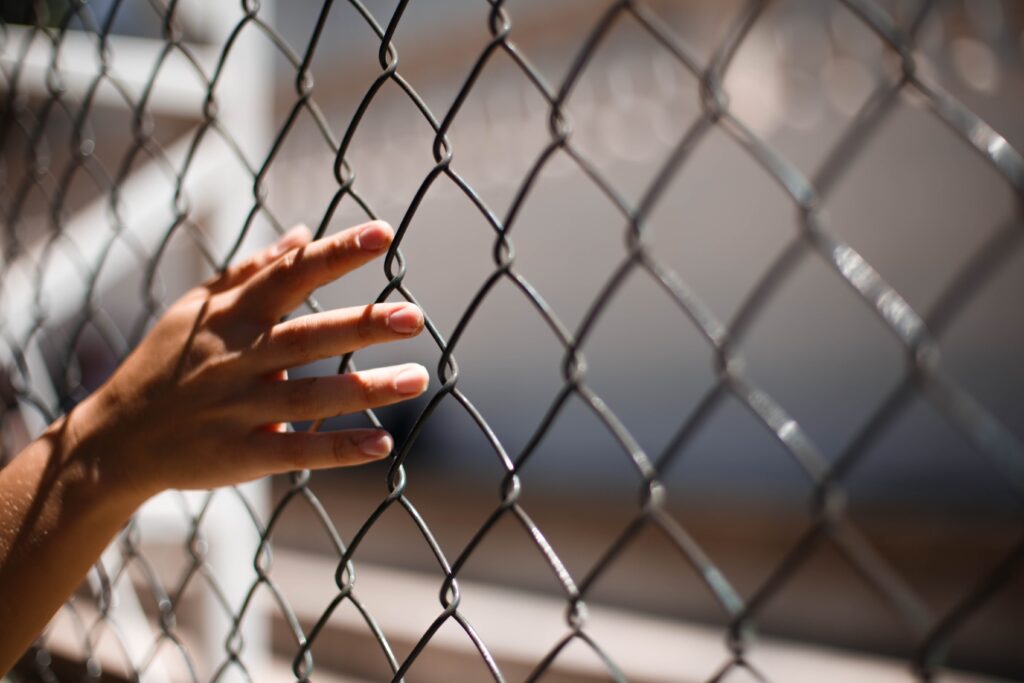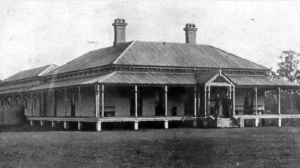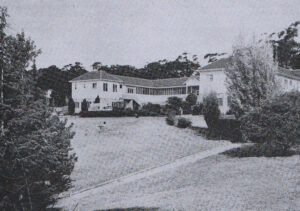The Department of Health and Human Services in Victoria has the power to remove children from their parents if the child is thought to be “neglected” or if the child has been charged or convicted of a criminal offence.
Likewise, Victoria Police can remove children from their homes if they suspect the child is being neglected, and they can arrest a child who is suspected of criminal offences or if they have run away from state care.
When children are removed from their homes, they become a “state ward”, and between 1954 and 1970, the Director of the Department was their legal guardian.
Before 1954, charitable and religious organisations would house the children. In the 1960s, however, a wide range of state-run institutions were opened, including reception centres, remand centres, youth training centres and children’s homes.
The Director of the Department had the power to place children in state-run institutions like Turana Youth Training Centre, Winlaton Youth Training Centre and Baltara Reception Centre – three of the harshest youth detention centres in Victoria.
At the Royal Commission, 13 former residents submitted evidence about the physical, emotional and sexual abuse they experienced at Turana, Winlaton and Baltara. They were abused by staff members, social workers and other residents.
The abuse had a devastating impact on their lives. Most struggled with their physical well-being, mental health, employability, family life and relationships. Most have suffered and continue to suffer from depression, alcohol and drug abuse.
Most of the survivors agreed the sexual abuse they experienced in state care ruined their lives.
The reporting procedure at each of these detention centres was deplorable. The children were rarely heard and never cared for. In this article, we explore the inadequacies of youth detention centres in Victoria from the 1950s to the 1990s.
Turana Youth Training Centre
Turana was an institution for boys and young men in Parkville, Melbourne. It operated between
1955 and the early 1990s until it was redeveloped as the Melbourne Youth Justice Centre.
The survivors said they experienced physical, emotional and sexual abuse during their stay at Turana. They were also forced to scrub the brickwork with a toothbrush as punishment to keep them occupied and compliant.
More than 200 former residents of Turana Youth Training Centre have suffered ongoing trauma, nightmares and mental health issues as a result of their time in state care.
Staff decided a resident was homosexual and tried to “cure” him with conversion therapy
Survivor Robert Cummings was being abused at Turana, but when he reported the abuse, the staff concluded Robert was homosexual and referred him for treatment to be “cured”.
The treatment was conversion therapy. He had an electrode strapped to his ankle, and he was shown images of naked men and women. He would receive an electric shock whenever a naked man appeared on the screen.
Robert said he was subjected to 12 aversion therapy sessions. When the other boys found out, he was labelled a “bum boy” and was sexually abused.
When Robert told the staff the other boys were abusing him, the aversion therapist said, “‘well, we will need to up your dosage of electricity”.
“Your arse belongs to us. If you don’t do what we say, you’ll go to Poplar House, and they’ll cut your throat down there”
Norman Latham was sent to Turana in 1962 when he was 15 years old. As soon as he arrived, a senior officer told him he had to do whatever the officers said, or he’d be sent to the infamous Poplar House.
Norman was sexually assaulted nine times by the same officer and 10 times by another senior officer. Each time, he was threatened into remaining silent. He did not want to be sent to Poplar House.
Joseph Marijancevic, on the other hand, lived at Turana when he was 11-years-old and again when he was 15 years old. He said he was cleaning the stairs with a toothbrush as punishment when an officer named Michael Monaghan directed him to a broom closet.
Monaghan “king-hit” Joseph in the back of the head. When he came to, he was lying face down on a table in the broom closet. He had been raped.
Another survivor known as BDB was raised as a boy but started identifying as a girl from a very young age. She was admitted to Turana in 1963 and was housed with 20 boys. From that day forward, she was repeatedly sexually assaulted by a larger, older boy.
Some nights, she’d bang on the door and ask to go to the toilet so she could avoid being assaulted. On one occasion, she was escorted from the dormitory by an officer who exposed his genitals to her and demanded she touch them.
She said the culture at Turana was “toxic” and “dangerous”.
Former worker heard rumours a boy had been raped with a toothbrush
A youth worker named Ashley Cadd, who worked at Turana Youth Training Centre, told the Royal Commission he heard “rumours about a couple of officers” and recalled hearing about a boy who had been raped with a toothbrush.
While he couldn’t confirm if the rumours were true, he knew there was a culture of controlling the boys through punishment, and there was no focus on child welfare at all.
Ashley told the commissioners the dorms were “hell on wheels” for the children. Sometimes, the boys would ask to sleep somewhere else – that’s when you knew they were scared for their own safety.
He also mentioned a small boy was transferred in the middle of the night to Poplar House, where 16-year-old offenders – including a teenager charged with murder – were housed. Ashley said the boy “would have been terrified”.
It wasn’t until Ashley left Turana that he learned the full extent of the problems there. The Department of Health’s focus was facility maintenance and keeping costs down – not the welfare of the children.
“I felt shocked. I felt ashamed,” he said.
“I think now the commission has opened the tin of worms they’re going to have a lot of cases to deal with.”
The superintendent knew the boys were being abused – but did nothing to stop it
David Green was the assistant superintendent at Turana in 1966 and the Superintendent in 1968.
In 2015, he told the Royal Commission a few boys had told him other inmates had sexually abused them, but there was no formal complaint-handling procedure – so he virtually did nothing to stop it.
“I would attempt to get the boy to talk or say to the chief or senior officer I think XX is troubled… keep an eye on it,” David said.
“They would say in effect they were being abused… they wouldn’t have used the term abuse. I have a memory of having a sense of him not telling me what happened … because he didn’t think I could protect him. I would not force [the boys] to reveal it.”
David told the commissioners boys would often keep the abuse to themselves out of fear of being targeted or labelled “a lagger” or “a dobber”.
When the commissioners questioned David about the reporting process, he said there was an ad hoc and informal approach to allegations of abuse. He also said overcrowding and lack of staff led to boys from violent and abusive homes being housed with hardened juvenile offenders.
David claims he contacted the Department of Health about the issue, but he was knocked back due to budget constraints.
Officers received “Mickey Mouse” training, and allegations rarely got passed up the chain of command
When Ashley submitted evidence to the Royal Commission, he said the staff were given “Mickey Mouse” training – meaning many things were glossed over, including how to handle allegations of child sexual abuse.
In the training material, sexual abuse was dubbed “unnatural acts”.
Many staff members were also ex-police officers, ex-army, or simply imposing figures.
Ashley said the boys were too scared to report abuse, and even if they did, their allegations were rarely passed on to anyone.
“It wouldn’t go anywhere. You had to walk on eggshells to do things,” Ashley said.
He also told the commissioners supervision at night was “horrifically” inadequate.
One officer would keep an eye on the children through a slot in the door, but they couldn’t turn on the light. Quite often, four or five boys would be housed in one room, and the officer couldn’t see what was happening inside.
“The boys may have been offenders but they’re human beings starting on the journey of life. I’m near the end of mine, but so help me God, I hope somebody puts the proverbial rocket under the department and makes them take responsibility for what they’ve undertaken and sworn to do, but never carried out.”
“You can’t rectify what was done in the past but you can damn we’ll make sure it doesn’t happen again.”
Baltara Reception Centre

Image: Pexels
Baltara was established in 1968 on the same campus as Turana. It was a remand centre designed for younger boys aged 10 to 15 years old. It was also a reception centre for teenage wards of the state waiting to be placed in children’s homes.
In 1991, Baltara was closed, and residents were moved into residential and reception units in
the community.
A 10-year-old boy was assaulted by eight to 10 boys in his dormitory
A survivor known only as BDA was admitted to Baltara in 1986 when he was just ten years old.
One night, BDA was trying to sleep when a group of eight to 10 boys surrounded his bed, holding their penises. The boys were aged between 12 and 16 years old. They each approached his bed and forced him to perform oral sex.
Within four months, BDA was returned home to his mother.
In 1993, BDA was sent back to Baltara. He’d been either living on the streets or bouncing between non-government institutions. As soon as he arrived back at Baltara, the abuse started again.
He was physically and sexually assaulted by the other boys in his dorm. On one occasion, two boys jumped into his bed and masturbated him or forced him to masturbate them.
BDA left Baltara in 1994 when he was 16 years old.
Another survivor named William Clark experienced a similar situation. When he was 12 years old, he was abused by an officer in the toilets and shower block.
The officer made William masturbate him in private and in front of the other boys. He would also rub his penis on William’s buttocks and sometimes even ejaculated on William.
William also told the Royal Commission the other boys would treat him the same.
Winlaton Youth Training Centre
Winlaton was established in Nunawading, Melbourne, in 1956. It operated as a youth training centre, a classification and assessment facility, a remand centre and a reception centre.
Girls and women aged 14 to 21 years old were admitted to Winlaton, although girls younger than 14 were often admitted.
The girls were admitted for having “severe management problems” while others persistently ran away from non-secure facilities.
In 1991, Winlaton was renamed the Nunawading Youth Residential Service and was redeveloped to be a mix-gendered facility. In 1993, it was relocated to the original Baltara site and became the Parkville Youth Residential Centre.
The girls were strip-searched, dehumanised and degraded
Apart from the ongoing sexual abuse, the girls were abused in other disturbing ways. For example, the girls were often strip-searched when they returned from leave or tried to escape.
Others were examined to see if they were virgins, despite telling the doctors they were. Their sexual history was also checked on a regular basis.
The examinations were rarely explained, and sometimes they were done without the girls’ consent. One of the workers told the Royal Commission the examinations were not mandatory and she would not consider them abuse.
The girls were also controlled through the provision of sanitary items. When they started menstruating, the girls would be given a single pad and had to show the officers it had been used before they were given another one.
Triad therapy was introduced so girls could raise any problems in a group setting – discouraging them from reporting abuse
An attempted “rehabilitation program” discouraged girls from reporting the abuse they experienced at Winlaton. It was called triad therapy.
Between three and 15 girls would get together under supervision and be forced to acknowledge or accept responsibility for their problems. Discussion points included:
- A person with a problem
- A person that used to have the problem but now does not
- A person who never had the problem.
Survivors said they were not comfortable raising their experiences with sexual abuse.
Likewise, the Royal Commission deemed triad therapy as an inappropriate forum for the girls to raise issues of abuse because it was not directed at sexual abuse, the people who performed triad therapy were not trained and the victim was forced to take blame or responsibility for their “problem”.
One resident was repeatedly sexually assaulted by her father, but this was seen as a dysfunctional family – not a crime
Katherine was 14 years old when she lived at Winlaton in 1979. Her father was allowed to visit her in the detention centre, and Katherine was also allowed to visit her mother on day and weekend leave. Her father had access to her there, too.
Katherine was being sexually abused by her father and told multiple social workers, youth workers and other staff members at Winlaton.
She even reported the abuse to the police when she was arrested for absconding from Winlaton. They did not investigate her allegations.
The social workers, youth workers and staff members did not report the allegations to the police, either. They did not see incest as a crime – just a symptom of a dysfunctional family.
The detention centre didn’t have reporting procedures, and the staff were confused about the decision-making process when it came to allegations of abuse. Because of this, they knowingly put Katherine in harm’s way by allowing her father to visit Winlaton.
While Katherine was at Winlaton, the medical staff also injected her with Depo Provera – a form of contraception – on a regular basis. Many of the residents received Depo Provera injections, often without their consent.
Depo Provera was not approved for general use in Victoria until 1991. It was regarded as “experimental” until that time.
Eventually, Katherine was transferred to Hillview Hostel, a non-government residential institution. After the transfer, Winlaton sent a letter to Katherine’s father telling him they knew about their “sexual relationship”, despite having no further involvement in Katherine’s care.
This was a dangerous move. Sending the letter alerted her father to the fact she had reported the abuse – putting her at risk of further harm. Winlaton also hadn’t put any safeguards in place for Katherine, so her father still had access to her.
In 1980, Katherine moved back in with her parents. The abuse continued for another 24 years until she told her counsellor about what had been happening. She told her counsellor she hadn’t tried to report the abuse to the police again because she found them judgemental and untrustworthy.
She felt like she was going to be charged for being a victim. There was also evidence the Victoria Police did not believe allegations of sexual abuse and would “grill” the victim for it.
In 2008, Katherine finally reported her father to the police. While he denied the allegations, a DNA sample was taken, and it proved he was the father of Katherine’s sons. In the end, he received 22 years imprisonment.
At Kelso Lawyers, we stand strong for the survivors of institutional abuse
It’s horrific to think these things have happened to vulnerable children in state care. Our Founder & Principal, Peter Kelso, experienced physical and emotional abuse as a ward of the state.
We understand how traumatic it can be to relive instances of sexual, physical or emotional abuse – but we’re here to listen, and we’re here to help.
Our team has extensive experience representing survivors of institutional abuse, and we have achieved positive outcomes for our clients.
We can do the same for you.
Get the justice you deserve with Kelso Lawyers. We want to hear your story. Call (02) 4907 4200 or complete the online form before you accept payment from the National Redress Scheme.
Image: Pexels





